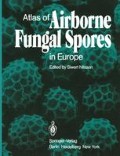Abstract
The Myxomycota are organisms which are distributed all over the world. During the vegetative state of their life-cycle, they appear as a diploid, multinucleate amoeboid mass of protoplasm, the plasmodium. Under specific environment conditions, the plasmodium develops into one or several sporocarps of great morphological diversity. Haploid spores are formed externally, or internnaly, e.g., in the Myxogastromycetidae (Fig.1); the majority of them are encysted spores. By germination of an encysted spore, one to for naked myxamoebae (flagellated swarm cells) are produced; they fuse to a diploid zygote. The zygote is, simply speaking, the beginning of a new plasmodium.
Access this chapter
Tax calculation will be finalised at checkout
Purchases are for personal use only
Preview
Unable to display preview. Download preview PDF.
Editor information
Editors and Affiliations
Rights and permissions
Copyright information
© 1983 Springer-Verlag Berlin Heidelberg
About this chapter
Cite this chapter
Käärik, A., Keller, J., Kiffer, E., Perreau, J., Reisinger, O. (1983). Terminology and Life-Cycles. In: Nilsson, S. (eds) Atlas of Airborne Fungal Spores in Europe. Springer, Berlin, Heidelberg. https://doi.org/10.1007/978-3-642-68803-4_2
Download citation
DOI: https://doi.org/10.1007/978-3-642-68803-4_2
Publisher Name: Springer, Berlin, Heidelberg
Print ISBN: 978-3-642-68805-8
Online ISBN: 978-3-642-68803-4
eBook Packages: Springer Book Archive

